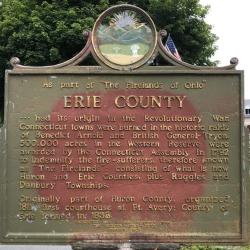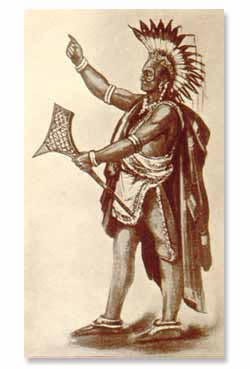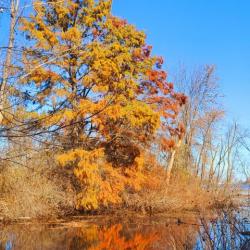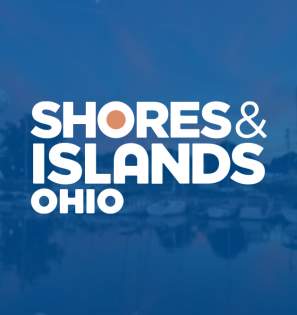 Part of our Time Traveler series
Part of our Time Traveler series
As we recognize November as Native American Heritage Month and continue toward Thanksgiving, many may conjure the image of happy pilgrims and indigenous tribes dining and celebrating together. Like much of history, however, the reality of life between colonists and the established indigenous societies was much more complex and often fraught. The early groups of European colonists often viewed the native population as savage beasts, at worst, and “the noble savage,” at best. The early reports were often clouded by these lenses and led to devastating consequences for our indigenous brethren as lands were taken and many tribes forcibly moved, or even decimated entirely by lack of food or disease. Thankfully, modern histories show the complex societies, cultures, and cultural and power exchanges that took place in the evolution of our nation.
Ohio (as does much of North America) has many city, county, and river names based on Native American tribes that lived on or near the areas named, or based on indigenous names for these places. In fact, both of Shores & Islands Ohio’s counties (Erie and Ottawa) are named after tribes that lived at one time or another in or around the region! Others similar names surround us such as Huron, Seneca, Wyandot, and many more. But who were these people? Which tribes actually lived in the region? And when were they forced west? While it is impossible to highlight the entire cultural histories of our indigenous tribes in the region, I will attempt to highlight a few important historical features and the local connections to the lands.
 The Erie tribe lived in northern Ohio, western New York, and northwestern Pennsylvania prior to the late 1650s. Many early French explorers referred to them as the “Chat,” (cat) most likely because of their use of raccoon pelts and tails on their clothing. Erie County, Lake Erie, and Erie, Pennsylvania are all named after this historic tribe. The Erie lived in palisaded long houses and spoke an unknown Iroquoian language. In the mid-1600s a feud broke out between the Erie and the Iroquois nations, after the Erie helped defend the Huron tribe during the Beaver Wars. The Iroquois burned all the Erie villages as a sign to not go against them. While it has been claimed that the Erie were completely destroyed, it is much more likely that the remaining people were absorbed into other nearby tribes.
The Erie tribe lived in northern Ohio, western New York, and northwestern Pennsylvania prior to the late 1650s. Many early French explorers referred to them as the “Chat,” (cat) most likely because of their use of raccoon pelts and tails on their clothing. Erie County, Lake Erie, and Erie, Pennsylvania are all named after this historic tribe. The Erie lived in palisaded long houses and spoke an unknown Iroquoian language. In the mid-1600s a feud broke out between the Erie and the Iroquois nations, after the Erie helped defend the Huron tribe during the Beaver Wars. The Iroquois burned all the Erie villages as a sign to not go against them. While it has been claimed that the Erie were completely destroyed, it is much more likely that the remaining people were absorbed into other nearby tribes.
The Ottawa/Odawa are an Algonquin speaking tribe that lived in Michigan, Southern Canada, and Ohio. Our own Ottawa County is named after this tribe. The Ottawa originated on the east coast and then gradually migrated west. They were long members of the Council of the Three Fires along with the Ojibwe and Potawatomi tribes. As the French came to the region, the Ottawa quickly became important partners in the fur trade. Interestingly, the name Ottawa/Odawa means “trader” in several native languages. Intertribal disputes arose over competition in the fur trade. The traditional balance of power had been upset by the arrival of European colonists, and the introduction of firearms created a disastrous environment. Some  of this upheaval lead to the destruction of the Erie as well. After the end of the French and Indian War, the Ottawa Chief Pontiac, worried that the British would take more native lands, formed an alliance with other regional tribes, leading to Pontiac’s Rebellion. In 1763 the Ottawa and their allies destroyed nine of 11 British forts around the Great Lakes, including Fort Sandusky. The British launched a counter-attack in the fall of 1764, leading to Ottawa surrender. However, Pontiac did not surrender until July of 1766. In a turn of events, the Ottawa sided with the British during the American Revolution. Following the revolution, in 1807, the Ottawa, Ojibwe, Potawatomi, and Wyandot signed the Treaty of Detroit (under US pressure) which ceded much of southwest Michigan and northwest Ohio to the US. The Indian Removal Act of 1830 drew the final nail in the coffin for the Ottawa in their native home. By 1837 they had been forcibly moved west to Iowa, then Kansas, then Oklahoma. Nearly half the Ottawa died within five years of moving to Kansas. Many slowly returned to the native regions and today many Ottawa live in Michigan and Ontario, Canada.
of this upheaval lead to the destruction of the Erie as well. After the end of the French and Indian War, the Ottawa Chief Pontiac, worried that the British would take more native lands, formed an alliance with other regional tribes, leading to Pontiac’s Rebellion. In 1763 the Ottawa and their allies destroyed nine of 11 British forts around the Great Lakes, including Fort Sandusky. The British launched a counter-attack in the fall of 1764, leading to Ottawa surrender. However, Pontiac did not surrender until July of 1766. In a turn of events, the Ottawa sided with the British during the American Revolution. Following the revolution, in 1807, the Ottawa, Ojibwe, Potawatomi, and Wyandot signed the Treaty of Detroit (under US pressure) which ceded much of southwest Michigan and northwest Ohio to the US. The Indian Removal Act of 1830 drew the final nail in the coffin for the Ottawa in their native home. By 1837 they had been forcibly moved west to Iowa, then Kansas, then Oklahoma. Nearly half the Ottawa died within five years of moving to Kansas. Many slowly returned to the native regions and today many Ottawa live in Michigan and Ontario, Canada.
The Huron/Wyandot/Huron-Wendat nation were originally a tribe of the northeastern woodlands. However, through migration and mostly through European colonization/forced displacement, they have also lived in Quebec, Michigan, Ohio, and eventually were forced to move west to Oklahoma and Kansas. Starting initially as an agreement between four tribes, the Huron later became the Wyandot when the Petun tribe joined the Huron Confederacy. The Huron/Wyandot occupied parts of Ohio in the 18th and early 19th centuries. Intertribal fighting, and later small pox and other diseases endemic to Europe (but not the US) took their toll on the tribe, causing it to lose many members. The Wyandot signed the Treaty of Detroit ceding their land claims in Ohio and Michigan and were eventually forced west. The city of Huron and Huron County (our nearby neighbor) are both named after the Huron tribe, as well as Wyandot county, a bit south of the Shores & Islands region. The tribe currently has members in Quebec, Oklahoma, Michigan, and Ontario.
 Now, many readers who are familiar with the area will wonder about Catawba. The history of this name is up for debate, but most commonly it is believed it was named after the native Catawba grape which flourished in the area. While the Catawba were and are an indigenous tribe, their traditional lands are in and around the Carolinas, quite a distance from Ohio. While some local tribes did make alliances and treaties with the Catawba, they never lived on land in our state, furthering the idea of the name being based on our local grape. Another native language connection to the area is “Chautauqua.” Lakeside Chautauqua (as well as Chautauqua New York) state that the word is from a Haudenosaunee (Iroquois) word meaning “two moccasins tied together,” describing the shape of Lake Chautauqua in NY. However, another etymology, also Iroquoian in root, states the word comes from a Seneca word, ja’dahgweh, meaning “one has taken out fish there.”
Now, many readers who are familiar with the area will wonder about Catawba. The history of this name is up for debate, but most commonly it is believed it was named after the native Catawba grape which flourished in the area. While the Catawba were and are an indigenous tribe, their traditional lands are in and around the Carolinas, quite a distance from Ohio. While some local tribes did make alliances and treaties with the Catawba, they never lived on land in our state, furthering the idea of the name being based on our local grape. Another native language connection to the area is “Chautauqua.” Lakeside Chautauqua (as well as Chautauqua New York) state that the word is from a Haudenosaunee (Iroquois) word meaning “two moccasins tied together,” describing the shape of Lake Chautauqua in NY. However, another etymology, also Iroquoian in root, states the word comes from a Seneca word, ja’dahgweh, meaning “one has taken out fish there.”
The list here could go on as many other tribes either lived or were forcibly moved to (and eventually through) Ohio. Sadly, today there are no recognized indigenous tribes or tribal lands left in Ohio. However, many who historically resided here do exist as federally recognized tribes in Michigan, Canada, and the American West. While these cultures were brutally removed from their lands by colonists, their history is not entirely erased in the region. Each of these cultures mentioned have (or had) complex society, traditions, and belief systems which I encourage you to research more on your own!



